![]()
Leofoto’s newest tripod, the Poseidon LP-284C, claims to be a lightweight carbon fiber travel tripod that’s both waterproof and sandproof. If true, this would truly set it apart and make it an indispensable companion for photo missions in just about any condition and any location. I put it to the test over the course of two weeks in Iceland, where it faced rain, wind, sand, surf, ocean, and even a volcano. Read on to find out how it fared.
Note: I have no affiliation with the company and purchased the tripod with my own funds
The Good
- Stiff and stable in moderate winds (10-20 mph)
- Impressively lightweight
- Leg twist locks are effective at keeping out sand and water
- Easy to rinse clean
- Adjustable legs allow you to get very close to the ground
- Seems likely to be very resistant to corrosion
The Bad
- Carabiner weight hook allows way too much movement in wind and is prone to falling out and getting lost
- Leg hinges may not be protected from sand or salt water
- Leg adjustment pull tabs did not work as expected: 2/3 tabs required user to pull and hold to adjust
- Not very tall
The Unknown
- Long-term durability and corrosion-resistance
- Material of the leg locks and threads
- Leofoto warranty
Initial Verdict
Excellent from the first leg section down: the design of the legs really does prevent sand and water infiltration into the locking threads and leg interior.
Multiple issues from the leg pull-tabs and hinges on up. It seems likely that if this tripod is going to fail, it would be because of something in this region. You can minimize the chance of issues by keeping this area free from sand and saltwater. Be sure to carefully inspect all the parts in this area to make sure they all work as expected, as it seems like there is inconsistent quality control.
Good value for the price, though you may be able to find a tripod similarly light and easy to clean with flip-locks for less money. Though it may be tough to find something that checks all those boxes and is as stiff/stable as the Leofoto.
![]()
![]()
MeFoto to Leofoto

Having recently returned from a visit to the desert and with a trip to Iceland coming up, I was sick and tired of having to constantly disassemble, wash, dry, re-grease, and re-assemble my MeFoto Roadtrip tripod every single time I set it up around sand (and even then still having sand grains stuck in the twist-lock leg threads). I was ready to get a tripod with flip-locks as a solution, but saw the new Leofoto Poseidon tripod and figured I’d give it a shot. In all fairness to MeFoto (now Benro), their customer service was outstanding the couple of times I needed support or a replacement part, but it seemed like there were alternatives that offered greater stability, a comparatively small and light form factor, greater resistance to the elements, and competitive prices.
I hadn’t heard of Leofoto before, but thanks to The Center Column and a number of user reports online, I was ready to give it a shot.
Quick Specs
The Leofoto Poseidon LP-284C is very similar to their LS-284C model, which as you can see from The Center Column‘s table, punches above its weight and sits alongside tripods from heavy hitters Really Right Stuff and Gitzo.
Here are some of the key specs:
- Maximum height: 50.8″ (it doesn’t have a center column)
- Minimum height: 6.3″ (it gets really low, great for getting up close with your foreground or for macro shots)
- Weight: 3.4 lbs (including ball head)
- Folded length: 21.3″
- Max capacity: 22 lbs
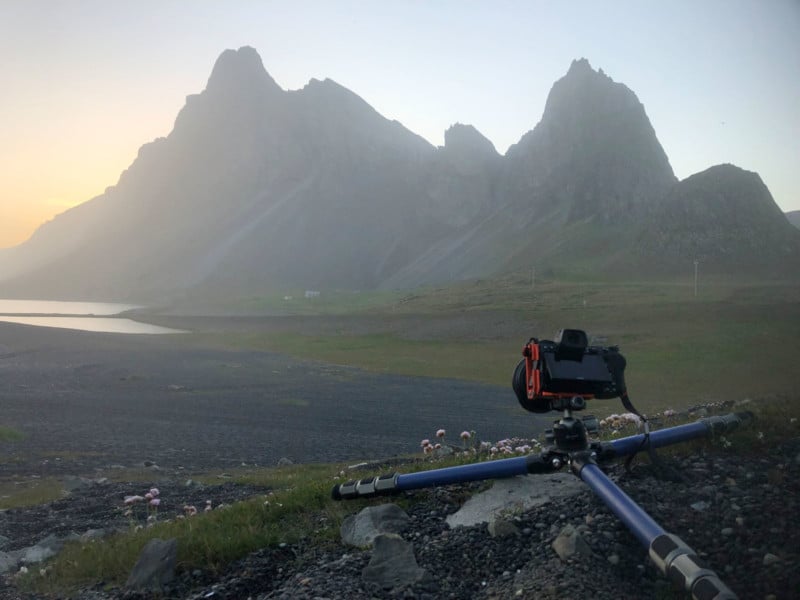
It’s made mainly out of carbon fiber, with titanium spiked feet, tube plugs, and threaded rubber feet. The tripod typically comes kitted with the Leofoto LH-30 ball head, which is made out of coated anodized aluminum. Note the ball head is rated to support 13.2 lbs, which is less than the tripod’s max capacity, so be careful if you plan to use heavy lenses or other gear on this tripod/ball head combo.
Real World Testing
I received my tripod just two days before leaving for Iceland, so when I got there it was unused and fresh out of the box.
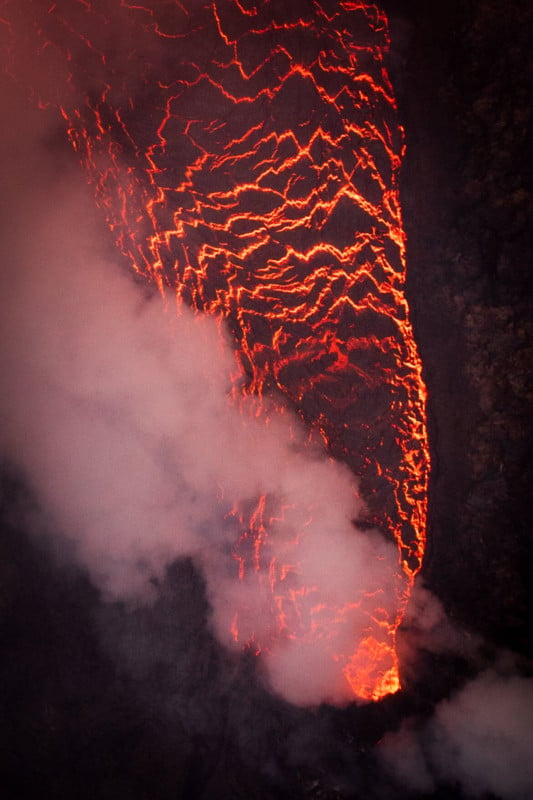
Zoom zoom
Its first test was on a hill with a slight breeze, looking at the still-erupting Geldingadalir volcano. I had a Nikkor 70-300 f/4.5-5.6 mounted, and zoomed in all the way to 300mm. The tripod was quick to set up and the legs locked securely, though the ball head did droop slightly even after tightening all the way. It wasn’t a lot and was easy to correct by aiming the lens slightly higher than I wanted it, but it was still noticeable and a minor inconvenience.
Wind and rain
Despite it being summer, bad weather seemed to follow me everywhere I went on the island. This meant I got to test the Poseidon tripod out in the wind and rain early and often. This tripod handled the rain without blinking. The internal o-rings/tube plugs inside the leg locks worked well and kept water from the leg sections that had been extended from entering and made it much quicker and easier to dry.
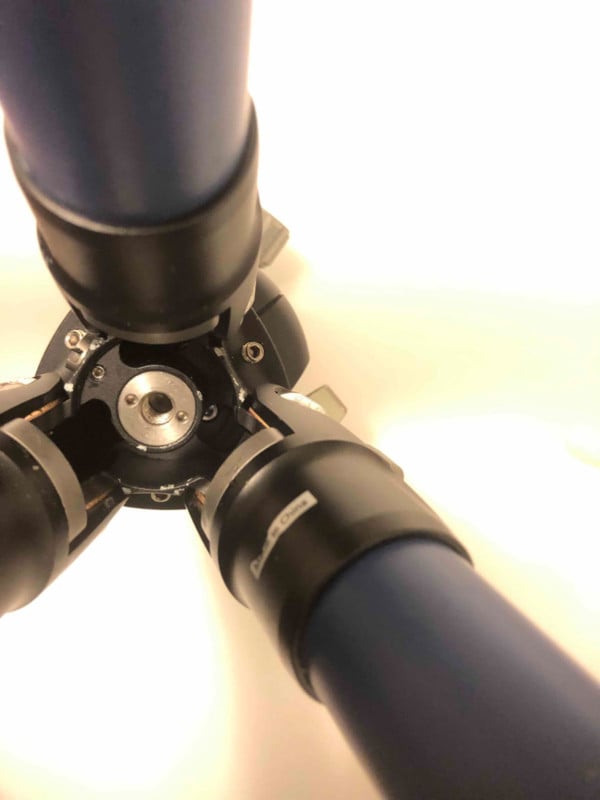
The tripod performed generally well in the wind, with one really big caveat (keep reading). As noted by The Center Column in their review of the LS-284C, this tripod is quite stiff. Even with all four leg sections extended, I had no problem getting sharp images even in decently windy (10-20 mph) conditions and wasn’t too worried about tripod stability/security either.
Here’s the caveat: the wind did pick up to 30+ mph on quite a few occasions, and that’s when I really wanted a good ballast weight to help anchor and secure the tripod. But unfortunately, this is where the Poseidon fell very short. Out of the box, it does include a threaded carabiner that can be screwed into the underside of the ball head after awkwardly splaying its legs, but here’s the thing: it didn’t stay in!
It took less than a day for my carabiner/screw combo to somehow loosen itself enough to fall out and disappear without my noticing. Fortunately, I had another one from a different Leofoto tripod, so I screwed that one in and secured it with duck tape. That worked but was a crude and temporary solution that required me to be constantly switching it between tripods. I also quickly discovered that the somewhat unique carabiner (rather than the more traditional hook) is a very poor design choice. Unlike a hook, the carabiner was connected via a metal ring, which lets the carabiner have a full range of motion. This is the opposite of what you want in the wind, as it lets your weight swing around much more readily, and it became a real problem with my backpack (my weight) swinging repeatedly into the tripod legs, causing vibrations and ruining multiple shots.
Sand and ocean
Ok, so the carabiner issue is real and somewhat significant, especially if you’ll be shooting in windy conditions. But I could MAYBE overlook that if the tripod lived up to its bold claims of being water- and sand-proof. I made no attempt to baby the tripod, taking it to multiple beaches, where the legs and feet were repeatedly submerged both in dry and wet sand and battered by the surf of the North Atlantic. I didn’t have enough freshwater to wash it off with, so I tried to simply rinse off sand in the ocean before letting it partially air dry and later collapsing the legs.
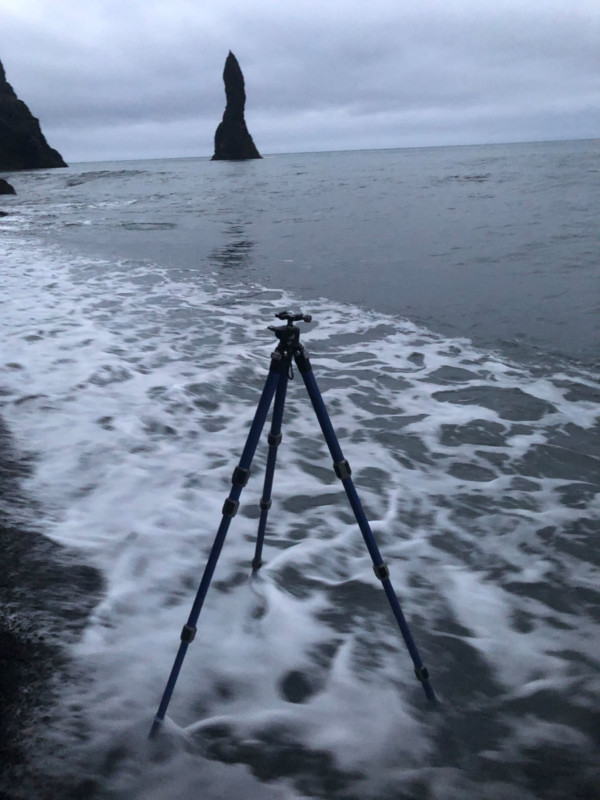
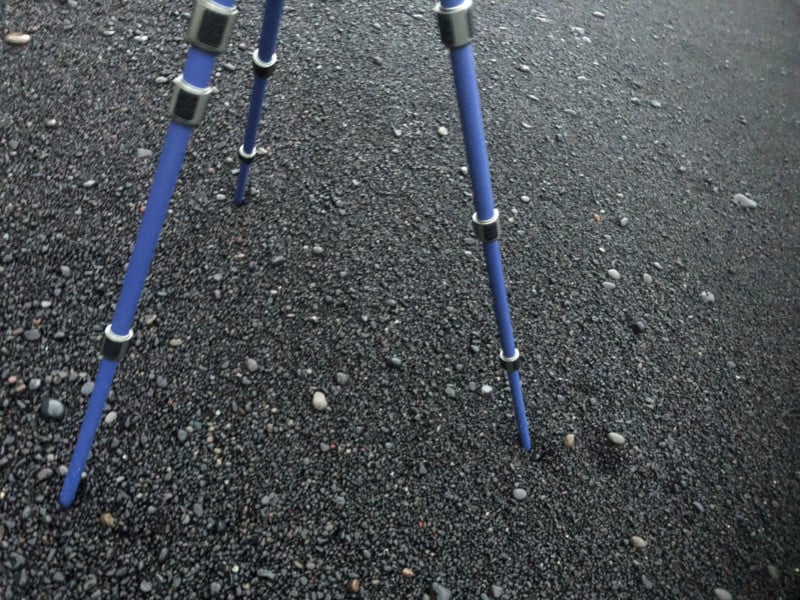
![]()
It was exposed to water (ocean and fresh) just about every day. I didn’t intentionally try to get sand stuck in the locks and did make sure to tighten the leg locks before sticking it in sand or ocean water, but beyond that, I fully exposed it to the elements to see how it would hold up over the course of two weeks.
After about one week, there was some salt residue clearly visible on the legs and some black sand that was building up on the very edges of the leg locks (where it should be blocked from entering the threads themselves by the o-ring and sealed locking mechanism). This was more or less expected given the conditions I was exposing it to.
![]()
When I finally had access to a sink, I simply unscrewed the leg locks all the way and gave the whole tripod a quick rinse (without disassembling). This seemed to work, though it seemed as though there MAY have been a few grains of sand that got through into the threads based on the feel and faint grinding sound from trying to tighten a couple of the leg locks.
And that was it! If I had been using my MeFoto Roadtrip tripod, I am 100% certain that the leg locks would be grinding away with plenty of sand infiltration into the threads. I was impressed.
After another week of use on land, mud, sand, river, and ocean, it was not much worse for wear save for some scratches around the top plate and leg angle adjustment pull-tabs.
Once I got home, I gave it a more thorough rinse (still without disassembling all the way) and let it air dry. This seemed to remove all the sand and salt residue, and the leg locks twisted cleanly and smoothly without any evidence of lingering sand grains.
Leg hinges
Closer inspection revealed that there were actually a fair number of tiny sand grains that had found their way onto the hinge washers. These hinges can be a major failure point, and in fact had failed on my MeFoto tripod, causing one leg to randomly detach and fall off. It’s important to keep these hinges free from saltwater and sand as the elements can quickly degrade the hinge grease.
![]()
Rinsing did not remove all the sand from the washers, so I didn’t want to unscrew the hinges to check for sand infiltration as sand could have become introduced by me from unscrewing them.
Leofoto makes no mention of if or how the hinges are protected from sand or saltwater on their product page, so it’s entirely possible that the hinges are unprotected. If that’s true, then I would consider them the weakest and most vulnerable points on the tripod.
While we’re talking about the leg hinges, it’s worth commenting on the pull tabs. In theory, it’s a straightforward design – you pull the tab out and can then adjust the leg angle, with the tab clicking into place at one of several locking points, including nearly horizontal. However, 2 of the 3 pull tabs on my tripod did not stay extended – I’d pull them out and they would immediately snap back in, so I’d have to pull the tabs out and hold them while also pushing the leg out, which was more awkward and more trouble than it should be. It also significantly slowed down the process of adjusting the legs.
Verdict: Worth It?
![]()
As of the time of posting, the non-waterproof version of this tripod, the LS-284C, cost $350, and the Poseidon LP-284C cost $50 more ($400). If you were already going to get the LS-284C and think you’ll ever want to shoot in sandy or wet conditions, I think it’s worth the extra $50. The tripod is quite stiff, impressively lightweight, and the sealed leg locks make it possible to use in sandy and wet environments without a second thought.
In my testing, the sealed leg locks worked well to keep out sand and water. They weren’t 100% perfect, but I would say they kept out 99+% of sand, which is huge and will be a very obvious and tangible improvement if you’re weary from having to constantly take apart your tripod to clean it out. And cleaning was very quick and easy.
![]()
One unknown is whether any parts will corrode over time. There was no evidence of any corrosion in the couple of weeks that I tested it, but this is something that would likely take longer to appear and would seriously interfere with the tripod’s proper functioning if it did appear. The use of titanium is a good choice to keep weight down and improve corrosion resistance, so I suspect the risk of corrosion (on the legs at least) is low. However, the only parts that Leofoto specifically calls out as being titanium are the tube plugs, foot spikes, and threads for the rubber feet. What about the rest of the leg locking mechanism, including the threads?
The Leofoto Poseidon LP-284C does have significant drawbacks that you should consider before buying. First, the carabiner ballast is a very poor design choice, allowing your weight to act like a sail with a full range of motion in the wind, and, at least for my tripod, it could not be fully secured – it would unscrew itself and fall out. That’s not good. After just a week, I gave up on it and abandoned trying to have any ballast to weigh down and secure the tripod. When the wind really picked up, I retracted the legs and lowered the tripod close to the ground. This works in some situations, but obviously not all.
Second, the hinges and leg adjustment pull-tabs are a concern. Not only is it unclear whether the hinges have any protection at all from sand and saltwater, but the pull tabs themselves seem to suffer from a real lack of quality control, with 2/3 of them not able to function as intended and requiring me to pull and then hold each in order to adjust the legs.
![]()
The way I think of this tripod is that it’s waterproof and sand-proof starting with the first leg section on down. Above that (the pull-tabs, hinges, top plate, and ball head) there is no indication of being water- or sand-proof, and care should be taken to minimize exposure to these elements as they can cause substantial wear and tear, shortening the lifespan of the tripod or requiring more frequent deep cleans and maintenance.
One final consideration is the Leofoto warranty. Though it’s advertised as coming with a 10-year warranty, I’d take that with a grain of salt. There is little info available online about how to obtain warranty service and very few reports of customers receiving warranty service. Leofoto is also based in China, which means that if you do need service, you would presumably need to ship the tripod there, which would not be cheap or quick for those of us not based in China. It’s possible Leofoto would cover the full cost of shipping, but at least from what I can tell, it’s a gamble as to whether there is any substance behind their 10-year warranty claim.
If you’re careful to take care of this tripod and are lucky enough to get one that doesn’t suffer from the quality control issues that mine did, this tripod could be a good value for the money. On the other hand, if you can find a stiff, stable, lightweight tripod with flip-locks (some people just don’t like flip-locks, but I don’t have any real problem with them) made from high-quality durable plastic or corrosion-resistant stainless steel for under $400, that would be very much worth considering, in my opinion.
About the author: Dan Mitler is an outdoor photographer and hiker. The opinions expressed in this article are solely those of the author. You can find more of Mitler’s work on his website and Instagram. This article was also published here.







0 comments:
Post a Comment